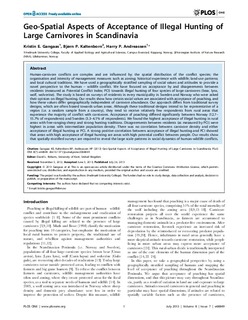Geo-Spatial Aspects of Acceptance of Illegal Hunting of Large Carnivores in Scandinavia
Journal article, Peer reviewed
Permanent lenke
http://hdl.handle.net/11250/134598Utgivelsesdato
2013Metadata
Vis full innførselSamlinger
Originalversjon
Gangaas KE, Kaltenborn BP, Andreassen HP (2013) Geo-Spatial Aspects of Acceptance of Illegal Hunting of Large Carnivores in Scandinavia. PLoS ONE 8(7): e68849. doi:10.1371/journal.pone.0068849 10.1371/journal.pone.0068849Sammendrag
Human-carnivore conflicts are complex and are influenced by: the spatial distribution of the conflict species; the
organisation and intensity of management measures such as zoning; historical experience with wildlife; land use patterns;
and local cultural traditions. We have used a geographically stratified sampling of social values and attitudes to provide a
novel perspective to the human – wildlife conflict. We have focused on acceptance by and disagreements between
residents (measured as Potential Conflict Index; PCI) towards illegal hunting of four species of large carnivores (bear, lynx,
wolf, wolverine). The study is based on surveys of residents in every municipality in Sweden and Norway who were asked
their opinion on illegal hunting. Our results show how certain social values are associated with acceptance of poaching, and
how these values differ geographically independent of carnivore abundance. Our approach differs from traditional survey
designs, which are often biased towards urban areas. Although these traditional designs intend to be representative of a
region (i.e. a random sample from a country), they tend to receive relatively few respondents from rural areas that
experience the majority of conflict with carnivores. Acceptance of poaching differed significantly between Norway (12.7–
15.7% of respondents) and Sweden (3.3–4.1% of respondents). We found the highest acceptance of illegal hunting in rural
areas with free-ranging sheep and strong hunting traditions. Disagreements between residents (as measured by PCI) were
highest in areas with intermediate population density. There was no correlation between carnivore density and either
acceptance of illegal hunting or PCI. A strong positive correlation between acceptance of illegal hunting and PCI showed
that areas with high acceptance of illegal hunting are areas with high potential conflict between people. Our results show
that spatially-stratified surveys are required to reveal the large scale patterns in social dynamics of human-wildlife conflicts.
